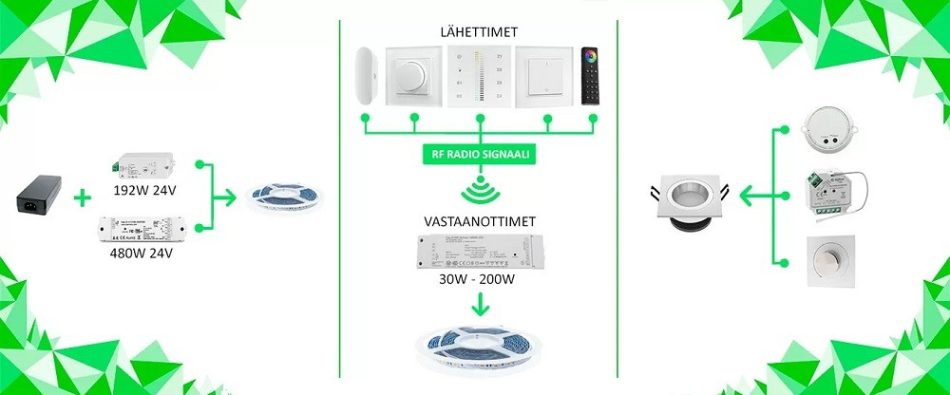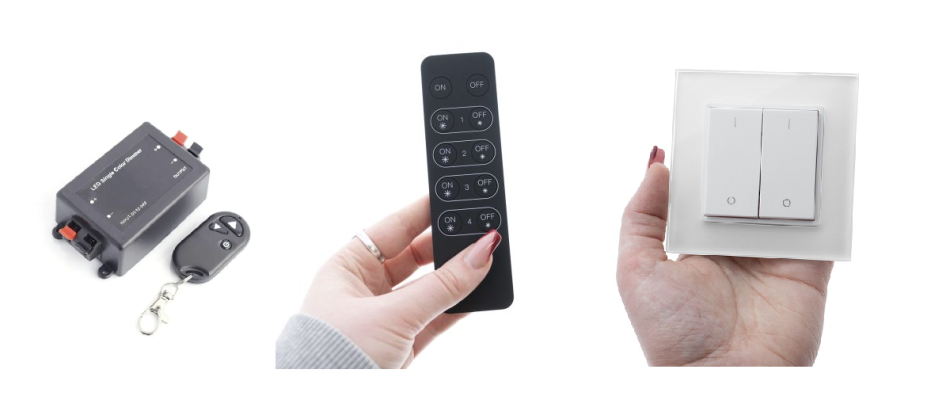[vc_row][vc_column][vc_column_text]LED lights are fast becoming the lighting of choice for many homes and businesses thanks to their energy efficiency and long lifetime. However, one of the challenges of LED lights is their lack of compatibility with traditional dimming methods. This is where RF dimming can become a solution.
RF (radio frequency) dimming allows remote control of LED lights, offering users more flexibility and convenience. This article discusses the advantages and disadvantages of RF dimming of LED lights and how it differs from traditional dimming methods. This article completes our series of articles on lighting dimming techniques.
The benefits of RF dimming of LED lights
One of the main advantages of RF dimming is the ability to control lights remotely, usually with a remote control.
Another advantage of RF dimming is its compatibility with a wide range of LED lights. Traditional dimming methods such as 0-10V and PWM are not compatible with all types of LED lights. RF dimming, on the other hand, is compatible with more LED lights because the RF receiver can incorporate different dimming techniques, making it a more versatile solution.
RF dimming also allows more precise control of the brightness of the lights. This allows for a smoother dimming experience and the ability to set the lights to a specific brightness level.

Disadvantages of RF dimming of LED lights
The main drawback of RF dimming is the potential for interference. RF dimming systems may operate on the same frequency as other wireless devices, such as Wi-Fi routers and Bluetooth devices. This can cause interference and negatively affect the performance of the dimming system. For example, the signal passing from the button to the receiver may be stopped because a faulty electrical device in the same electrical phase produces RF interference at exactly the same frequency.
In Europe, RF equipment must have LoRa frequencies set in two bands: EU433 (433.05-434.79 MHz) or EU863-870 (868.1-868.5 MHz). When buying RF equipment, check that it complies with the standards.
Another drawback may be the short range. Depending on the manufacturer, the RF has a range of 10 to 30 metres. Each wall also halves the range.
How does RF dimming differ from traditional dimming techniques?
It is important to note that RF dimming is not a dimming technique but a way to carry a command to a dimmer which is always connected to the luminaire. So it’s a wireless way of giving a command to the dimmer.
Traditional dimming uses wires, but RF dimming uses radio frequency signals to control the lights. The dimming mode of the controller or LED controller can be any, such as PWM or TRIAC.
Another key difference between RF dimming and traditional dimming methods is compatibility. As mentioned earlier, RF dimming is compatible with a wider range of LED lights (because there are several types of dimming), while traditional dimming methods may only be compatible with certain types of LED lights.
RF dimming with a twist
Suppose you have a light bulb in your room and you want to adjust its brightness.
Think of a light bulb as a balloon full of light. The more light you add to the balloon, the brighter the bulb becomes. The RF dimming system is like a remote control that adjusts how much light is in the balloon. The remote control uses radio signals. These are special messages that travel through the air and send messages from the remote control to the lamp. That is, by pressing the remote control to dim, the lamp dims.
History of RF dimming
The history of RF dimming is not entirely certain, but Lutron was the first to commercially exploit the 2-way RF remote control for light control, introducing the RadioRA light control system in 1997.

What is the difference between RF tuning and ZIGBEE tuning?
RF dimming and Zigbee dimming are both technologies used to remotely control the brightness, colour and temperature of LED lights. However, they have some key differences in their characteristics and applications.
RF-dimming
RF dimming uses radio waves to communicate between the dimmer switch and the LED lights. This allows remote control of lights and the possibility to control several lights at once. RF dimming is typically used in residential and commercial premises and can be controlled by remote control or a smartphone app. RF dimming uses the 434 or 869 MHz frequency. Most RF devices are not compatible with each other, so when you choose a supplier, you’re stuck with it.

Zigbee dimming
Zigbee dimming, on the other hand, uses the Zigbee wireless protocol to communicate between the dimmer switch and the LED lights. It is also RF, meaning radio frequency transmission, but in the 2.4Ghz range. This allows for more precise control of lights and the ability to integrate with other smart home devices such as thermostats and security systems. Zigbee voice is typically used in smart home applications and can be controlled by a smartphone app or voice commands.
One of the main differences between RF tuning and Zigbee tuning is the level of control and integration they provide. RF dimming is generally simpler and easier to use, while Zigbee dimming offers more advanced features and integration with other smart home devices.
Another difference is power consumption. Zigbee dimming devices have low power consumption because they run on battery power and have a built-in sleep mode, while RF dimmers tend to consume more power because they may run continuously. Both use Enocean technology, which means no batteries are needed. Just using the switch makes it electric.
In terms of compatibility, RF dimming is compatible with a wide range of common LED lights. Zigbee dimming as a technology has an identical range of dimming technologies for dimming LED lights, but in addition there are Zigbee bulbs that can be limited to specific brands and models of LED lights. Make sure that when you buy a Zigbee lamp, it works with Zigbee standards and not just the manufacturer’s own app.
Which one is right for me?
To put it simply, If you only need to control a few lights, use RF, if many rooms, use ZIgbee. Or if you don’t need phone apps or a connection to your home automation, you can have a basic RF dimmer. For more versatile control and home automation, use Zigbee.
Summary
RF dimming of LED lights provides a convenient and versatile solution for controlling the brightness of LED lights. However, it is important to consider the cost and potential interference when deciding whether or not to use RF dimming. Ultimately, the decision depends on the specific needs and requirements of the space and the individual.
RF Dimming – Frequently Asked Questions
[/vc_column_text][vc_toggle title=”What is RF dimming of LED lights?”]RF dimming is a method of controlling the brightness of LED lights using radio frequency signals. This allows remote control and better compatibility with a wide range of LED lights, as the RF dimmer can accommodate a wide range of dimming techniques.[/vc_toggle][vc_toggle title=”How does RF dimming differ from traditional dimming methods?”]Traditional dimming methods, such as 0-10V and PWM, rely on sending a low voltage signal along cables to the LED lights to adjust the brightness. RF dimming, on the other hand, uses radio frequency signals as a companion to the dimmer.[/vc_toggle][vc_toggle title=”Can RF dimming be used with all types of LED lights?”]Yes, RF dimming is compatible with a wide range of LED lights. However, it is important to first check the compatibility of the LED light before using RF dimming.[/vc_toggle][vc_toggle title=”How can RF dimming be controlled?”]RF dimming can be controlled by remote control, a smartphone app or even voice commands via a smart home assistant.[/vc_toggle][vc_toggle title=”What are the benefits of RF dimming of LED lights?”]The benefits of RF dimming include remote control, compatibility with a wide range of LED lights and more precise control of light brightness.[/vc_toggle][vc_toggle title=”What are the disadvantages of RF dimming of LED lights?”]The drawbacks of RF dimming include potential interference.[/vc_toggle][vc_toggle title=”Can RF dimming interfere with other wireless devices?”]Usually the other way round. RF dimming works on the same frequency as other wireless devices and Bluetooth devices. This can cause interference and negatively affect the performance of the dimmer system.[/vc_toggle][vc_toggle title=”How much does an RF dimming system cost?”]The cost of an RF dimming system can vary depending on the characteristics and features of the system. It can be cheaper or more expensive than traditional dimming methods, but as an example, a TRIAC dimmer 50-150€ or TRIAC dimmer receiver + wireless button = 90€[/vc_toggle][vc_toggle title=”Is RF dimming a good choice for my farm?”]The decision to use RF dimming depends on the needs and requirements of the space and you. It is important to consider the cost and potential interference when deciding whether or not to use RF dimming. SE is a good choice for controlling a single light, for example, but not the whole house.[/vc_toggle][vc_toggle title=”Can RF dimming be used in commercial premises?”]RF dimming can be used in both residential and commercial premises. It can offer more flexibility and convenience in adjusting lighting to the needs of the space, but only in small areas. For larger installations, ZIgbee wireless.[/vc_toggle][/vc_column][/vc_row][vc_row][vc_column][vc_column_text]
Led dimming specialist
LedStore has been an expert in LED lighting and lighting design since 2010. We have our own product design, so our products are technically state-of-the-art. Products have quarantee for up to 7 years. We also carry out lighting maintenance.
We focus on temperature-controlled and high colour rendering lights, so they work brilliantly and last a long time. We make around. 500 lighting designs for our clients’ sites. Read more here or order a lighting design
We offer a service of custom-made LED strips, i.e. custom-made LED strips in aluminium profile. Also installed. Did you know? LedStore offers lighting design from 99 euros for the whole house!
Remember that we are always available to support you along the way, by email(myynti@ledstore.fi) and by phone (045 251 4510). As always, feel free to share photos of your own projects on social media at #ledstorefi IG and ledstore.fi FB. We love to see the cool things our LEDs do, and it helps to provide inspiration for those who are not sure about the power and awesomeness of LEDs. Did you know that we already have over 3500 pictures of our LED installations in our Gallery!
Photo gallery of Led lights:
Product gallery: pictures of products in different installation locations
Indirect light: indirect light in different spaces
Room-specific: Light in different rooms
References: complete houses that have been photographed[/vc_column_text][/vc_column][/vc_row]

